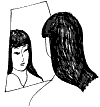Poetry also works through images. In the case of haiku, the images are not "imaginative" in the sense of invented, fantasised or fictionalised. They are usually closely observed aspects of nature. They are real experiences. They are images in the sense that they give the reader pictures (and sounds, textures and smells) with which to recreate the experience as a whole. They
show the experience, in the vivid present; they do not
tell about it, reporting on something that has passed and summing up the judgement to be made about it. The reader is in the middle of it, not being told about it second hand.
Thoughts and ideas: If mental events are the subject matter of a poem, then they are expressed through the strong feelings they arouse, or through images or experiences, not baldly, as thoughts. Essays (in philosophy or journalism, for example) are the right forms for the direct expression of thoughts, ideas, analysis and judgements. Creative writing is different, and works the opposite way.
Academic language has a tendency to generalise; literary language has a tendency to the concrete. This is why haiku are more immediately grasped by younger children than by sophisticated students in an academic environment. Academics have to change mind-gear to do creative work which is not academic.
Essays use generalisations, abstract language, theories, explanations, analysis, judgements, and sum up what conclusion is to be reached. They tell. None of these things is right for a poem.
Poems (and other literary forms) use concrete situations, named objects, fully imagined scenes brought to life in vivid detail at a particular moment in time, avoid abstractions, and leave the reader to draw the conclusion. They show.

WRITE
Can you tell a phoney?
Write by each of the lines in the following statements set out in haiku-like form,
"concrete" or "abstract,"
"general" or "particular,"
"sensation" or "idea"
and "conclusion," where it is appropriate.
When you have finished, put a line through the "poems" which are obviously essays masquerading as poems, and are not real poems at all!
1. I always feel
that life is so sad Ė
we are alone.
2. On the dewy grass
to one side of the path
a single footprint.
3. Wasp nest
perfect, in the rafters
of a ruined house.
4. Insect architecture
is intricate and beautiful,
a marvel of cooperation.
Here is a more difficult case: it is partly about a thought, but it is set in a definite place at a particular time, and the thought is a kind of sensation, is it not?
5. Walking at night,
sound of the cold river,
thoughts of sleep.
Poetry also sometimes enacts the experience which is the subject of the poem. This is another way in which the tendency of poetic language is to make things concrete, to be the meaning, using the rhythmic possibilities of language.
Which of the following haiku-like forms shows you the experience by enacting it, rhythmically (how does it do this?) and which tells you about it? Write shows or tells next to each poem, and say what it is about the sound quality of each of the shows ones that rhythmically enacts the subject.
Walking the snow-crust
not sinking
sinking
In deep snow
one can be uncertain
about oneís footing
crow follows crow;
a hedgesparrow hops on a
moss-covered grave
I saw a sparrow;
its quick little movements
were funny
Insects die
as the summer season ends.
They sting no more.
Summerís end nears Ė
now the slow bee allows
stroking of fur
Note to Teachers:
In discussing the poems with your group, keep referring back to the principles of "Show Donít Tell" and the questions set. There are good reasons why one version of a theme or poem is to be preferred to another; do not let the clever debaters in your class get away with the argument that it is "all a matter opinion, of taste!" It isnít.

REFLECTION
You should have crossed through numbers two and four. They are generalisations more suited to the essay form than poetry. Numbers one, three and five are all highly specific images, vivid to the senses, and good poems which are suggestive and resonant, leaving plenty of room for metaphorical interpretation by the reader.
In "Walking the snow-crust Ö" one is there! The reader hesitates, heart in mouth, teetering, between lines two and three, and thus enacts the action which is the subject.
"Crow follows crow Ö" uses long-vowelled, heavily-accented slow syllables for the slow crows, and a scatter of short-vowelled syllables, many of them unaccented, for the quick hopping movement of the hedgesparrows. One feels the contrast enacted in the process of reading. Try reading it aloud.
"Summerís end nears Ö" is full of buzzy s and z sounds. It has a series of soft murmuring vowells. Lines two and three are a succcession of open o sounds. It creates an appropriate sound-world for the drowsiness of the subject: tiredness, tenderness and approaching death.
The other "poems" ("In deep snow," "I saw a sparrow," and "Insects die") are phoneys. They tell, and should be cast in some other medium (a bin, for example).


